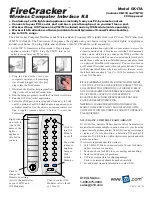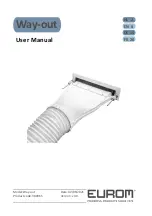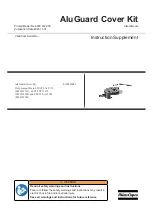
4
Windscreens and Nose cones
Wind induced noise can be reduced by using a windscreen. This can offer some protection against dust
particles and mechanical damage. In the presence of high-speed airflow from a well-defined direction, such
as wind tunnels, a nose cone is recommended. When using windscreens and noise cones, the frequency
response of the microphone will be attenuated at higher frequencies.
Clamps and stands
When holding a microphone in place, it is important to minimize the influence of the stand on the sound
being measured. This can be accomplished by using low profile stands and clamps available from PCB.
Cables and Electronics
PCB carries LEMO
cables as well as coaxial cables with BNC and 10-32 connectors. Traditional exter-
nally polarized microphone power supplies along with a variety of ICP
®
signal conditioners are available
that will fit almost any need.
6.0
Maintenance
Microphones are very stable over long periods of time, provided they are handled and stored properly. The
microphone contains fragile components that can be damaged by misuse, in particular the diaphragm, which
is made up of a very thin proprietary material and should be kept clean of dust, dirt, moisture and free any
type of imperfection (scratch, dent, etc.).
The microphone’s grid cap is designed to let the true sound pressure level through to the diaphragm while
preventing items from coming in contact with it. We do not recommend that you ever remove the grid cap
or clean the microphone. If you take the precautionary measures to keep the microphone clean and dry, it
should not be necessary. Should you need to remove the grid cap to replace it with PCB’s enhanced rugged
grid cap (shown below, and as an independent part of a rugged kit) to extend the lifespan of the precision
measuring device, caution should be taken to ensure the delicate diaphragm sensing element remains un-
touched and safe.
Use of accessories, like windscreens, and desiccants will help keep moisture off the microphone and main-
tain the specified sensitivity level. Nose cones will help keep turbulence off the microphone diaphragm and
allow the sound pressure to be measured with greater accuracy.
Keep the microphone and preamplifier assembled while preparing for testing. Keep the rubber maintenance
caps on the preamplifier’s electrical connector only. Do not place these rubber caps over the microphone.
This will create a vacuum and undo pressure on the microphone diaphragm, which can stretch the dia-
phragm and cause a change in sensitivity. Store the microphones and preamplifiers in their protective cases
when not in use.
Dust, rain, oil, moisture or exposure to extreme temperatures may adversely affect the microphone and
preamplifier’s performance. If the microphone or the inside of the connection area of the preamplifier be-
comes contaminated, use a light pressure rubber bulb to gently blow clean, dry air onto the unit in order to
remove the dust. In the event that you absolutely must take off the grid cap and clean the microphone
diaphragm, we recommend using a blow bulb or a light pressure, clean and dry air hose to gently blow
contamination off the diaphragm. The direction of the air should be parallel with the diaphragm, not directly
(0 degree incidence) pointed at the diaphragm. Do not touch the microphone’s diaphragm with your fingers
or let it come in contact with any sharp or pointed object. Please note that any contact to the microphone’s
diaphragm can negatively impact the sensitivity and long term stability of the microphone.






























